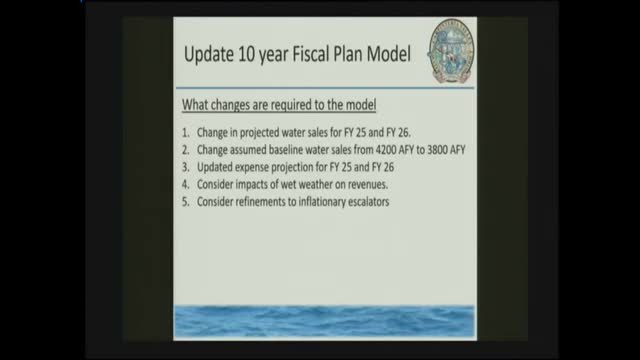Board evaluates financial model for $72M water treatment plant amid rising costs
February 29, 2024 | Carpinteria City, Santa Barbara County, California

This article was created by AI summarizing key points discussed. AI makes mistakes, so for full details and context, please refer to the video of the full meeting. Please report any errors so we can fix them. Report an error »

In a recent meeting of the Carpinteria Valley Water District, held on February 28, 2024, officials grappled with the ongoing challenges of fluctuating water sales and the financial implications of a significant capital project. The discussion revealed a complex interplay between drought conditions, wet weather, and the district's revenue model, which has been under strain due to unpredictable water usage patterns.
As the meeting unfolded, it became clear that the district has been experiencing a troubling trend: water sales have dropped significantly, even before the recent rains. This decline has been attributed to a cyclical pattern of drought and heavy rainfall, which has led to inconsistent water consumption. Officials noted that the historical sales figures, once projected at 4,200 acre-feet, may need to be revised down to around 3,800 acre-feet to better reflect current realities. This adjustment is crucial for accurately forecasting revenues and ensuring the district meets its financial obligations, including bond covenants.
The conversation also turned to the district's ambitious capital project aimed at enhancing water treatment capabilities. However, the project has faced substantial cost increases, with estimates soaring from $16 million to $41 million. This escalation has raised concerns about the project's viability and the potential need for significant rate increases to cover the costs. Officials are exploring various strategies, including value engineering to reduce expenses and possibly phasing the project to spread out costs over time.
Compounding these challenges, the district recently lost a $10 million grant due to state budget cuts, further straining its financial outlook. The board is actively seeking alternative funding sources and considering delaying the project to allow for more time to secure additional grants and adjust financial strategies.
As the meeting concluded, the urgency of the situation was palpable. Board members expressed a commitment to finding solutions that would not only stabilize the district's finances but also ensure a reliable water supply for the community. The discussions underscored the delicate balance between managing immediate financial pressures and planning for long-term sustainability in the face of climate variability. The district's next steps will be critical in shaping its future and maintaining the trust of its constituents.
As the meeting unfolded, it became clear that the district has been experiencing a troubling trend: water sales have dropped significantly, even before the recent rains. This decline has been attributed to a cyclical pattern of drought and heavy rainfall, which has led to inconsistent water consumption. Officials noted that the historical sales figures, once projected at 4,200 acre-feet, may need to be revised down to around 3,800 acre-feet to better reflect current realities. This adjustment is crucial for accurately forecasting revenues and ensuring the district meets its financial obligations, including bond covenants.
The conversation also turned to the district's ambitious capital project aimed at enhancing water treatment capabilities. However, the project has faced substantial cost increases, with estimates soaring from $16 million to $41 million. This escalation has raised concerns about the project's viability and the potential need for significant rate increases to cover the costs. Officials are exploring various strategies, including value engineering to reduce expenses and possibly phasing the project to spread out costs over time.
Compounding these challenges, the district recently lost a $10 million grant due to state budget cuts, further straining its financial outlook. The board is actively seeking alternative funding sources and considering delaying the project to allow for more time to secure additional grants and adjust financial strategies.
As the meeting concluded, the urgency of the situation was palpable. Board members expressed a commitment to finding solutions that would not only stabilize the district's finances but also ensure a reliable water supply for the community. The discussions underscored the delicate balance between managing immediate financial pressures and planning for long-term sustainability in the face of climate variability. The district's next steps will be critical in shaping its future and maintaining the trust of its constituents.
View full meeting
This article is based on a recent meeting—watch the full video and explore the complete transcript for deeper insights into the discussion.
View full meeting
